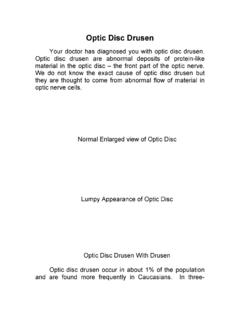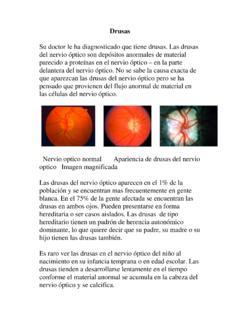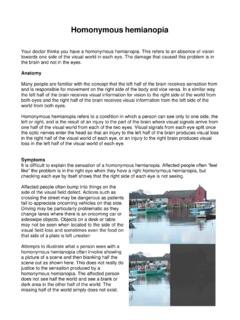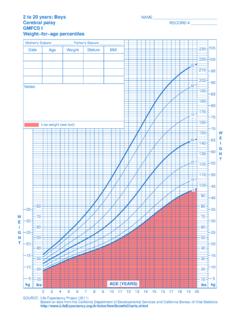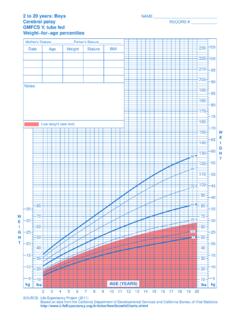Transcription of Microvascular Cranial Nerve Palsy
1 Microvascular Cranial Nerve Palsy Your doctor thinks that you have a Microvascular Cranial Nerve Palsy . This is one of the most common causes of acute double vision in the older population. It occurs more often in patients with diabetes and high blood pressure. Microvascular Cranial Nerve palsies have often been referred to as diabetic palsies. They will get better and essentially always resolve without leaving any double vision. Anatomy: The eyes are moved by 6 extra-ocular muscles. Four of these are rectus muscles (superior, inferior, medial, and lateral) that attach to the front part of the eye (just behind the iris, the colored portion of the eye).
2 Two muscles (the superior and inferior oblique) attach to the back of the eye. These two are responsible for some up and down (vertical) movement and most of the twisting movement of each eye. These 6 muscles receive their signals from 3 Cranial nerves (the IIIrd [oculomotor], IVth [trochlear], and VIth [abducens]). These nerves originate in the brain stem (at the base of the brain) and enter the eye socket through a fissure in the bone of the skull behind the eye. The blood supply to these Cranial nerves is from branches off the basilar artery in the brain stem and from branches of the internal and external carotid artery once they leave the brain stem.
3 The VIth Nerve (abducens) activates the lateral rectus muscle which moves the eye out (away from the nose). The IVth Nerve (trochlear) goes to the superior oblique muscle (which moves the eye down when it is in toward the nose). The IIIrd Nerve (oculomotor) sends branches to the inferior (moves the eye down), superior (moves the eye up), and medial (moves the eye toward the nose) rectus, and the inferior oblique muscles. The IIIrd Nerve also sends signals to the pupil (to make it smaller) and to the eyelid (to hold it up).
4 Physiology: Interruption of the blood supply to one of the Cranial nerves causes it not to work. If there is interruption of signal to the VIth Nerve (which innervates the lateral rectus muscle) the affected eye will not be able to move to the outside. The patient will be aware of side-to-side double vision that will be worse (further separation) when the patient looks towards the affected side. If the IVth Nerve is affected (innervating the superior oblique muscle) the patient will be aware of vertical double vision (one on top of the other).
5 This will be worse when looking to the side opposite the involved Nerve . Patients rapidly discover that they may be able to eliminate or decrease the double vision by tilting their head towards the opposite shoulder. When the IIIrd Nerve (which goes to multiple muscles) is involved the eye may be limited in up, down, and gaze toward the nose. The patient is usually aware of combined vertical and side to side double vision although there may be no double vision at all since the lid droops and may block the second image. In the case of Microvascular interruption we are not sure what causes the loss of blood flow (which deprives the Nerve of oxygen).
6 This may occur due to blockage of small arteries related to high blood pressure or hardening of the arteries. In young patients this may occasionally occur in patients with migraine. The affected vessels usually supply the nerves between the brain stem and the muscles within the eye socket. Occasionally there may be a problem of blood flow to the nerves within the substance of the brain stem. Associated with the blocked vessel there is often a decrease in the blood flow to the covering of the brain (the dura). This decrease in blood flow can produce pain that is felt around the eye.
7 The nerves are not permanently injured and over a period of 6 to 12 weeks the function should recover. Symptoms: Dysfunction of one Cranial Nerve will produce weakness in one or more muscles. If the eyes aren't moving together the patient will experience blurred or double vision. If only the VIth Nerve (innervating the lateral rectus) is affected the double vision will be side to side. If the IIIrd or IVth Nerve is affected there will most commonly be some vertical ( one on top of the other ) double vision. This will vary depending on the direction of gaze.
8 Pain in or around the eye is related to lack of blood flow to the dura (covering of the brain) and commonly occurs at the onset of double vision. This pain should disappear over a few days. Signs: The signs of a Microvascular Cranial Nerve Palsy are usually problems with eye movement. If severely affected, the eye may not be able to move at all in one or more directions. With incomplete involvement there may only be a slowing of movement. When the IIIrd Nerve is involved there is almost always lid droop (ptosis). In spite of the fact that the IIIrd Nerve also innervates the pupil, in most cases of Microvascular IIIrd Nerve Palsy patients will have a normal sized and reactive pupil.
9 About 20% of patients with Microvascular IIIrd Nerve Palsy will have some pupillary enlargement. Those patients who do have an enlarged pupil do need to be studied to make sure that there is no other cause of the IIIrd Nerve Palsy (such as an aneurysm). Diagnosis: The most important issue in diagnosing a Microvascular Cranial Nerve Palsy is whether it fits an expected pattern and whether it is "isolated." While it is possible for multiple Cranial Nerve palsies to have a Microvascular cause all patients with more than a single Nerve Palsy or with other neurologic findings must have a work up (neurologic examination and imaging study) before the diagnosis is accepted.
10 Even more importantly (whether or not the patient has had a work-up) if the Cranial Nerve Palsy fails to resolve completely over 3 months additional work-up is indicated. All patients with presumed Microvascular Cranial Nerve palsies should have their blood pressure and blood sugar checked to make sure they do not have diabetes or hypertension. There are many other causes of Cranial Nerve palsies so additional work up such as CT or MRI scans or even an angiogram to rule out an aneurysm may be necessary. A decision to order other tests depends on your symptoms and most importantly how you do.
